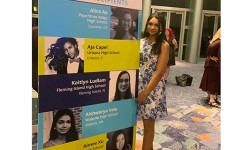By Amelia Tarallo
Hometown Weekly Staff
Today, there is more of a push than ever to encourage girls to join STEM programs, whether it be at a national or even local level.
To that end, SWENext (Society of Women Engineers) members Aishwarya Velu and Jenna Allman have organized a program this summer to get local Walpole girls excited about science. The girls kicked off their program on Monday, July 15, at the Walpole Library.
Velu and Allman began with a quick introduction before launching into their first experiment. The participants paired off for the experiment, like lab partners, ready to learn all about science. Each pairing was given a plate, a cup of milk, and some dish soap. The girls were instructed to carefully fill the plate up with milk. Then, each team picked some neon food coloring to add to the milk, some making careful patterns with drops of color. “You only want to use two or three colors,” advised Allman.
The girls didn’t know it yet, but adding too many different colors could ruin the experiment.
For the final step, each partnered group took some dish soap, dipped a Q-Tip in the soap, and gently added it to their mixture. Instantly, the colors seemed to push as far from the soap as possible, dashing across the milk and creating a tie-dye-like design. The colors merged together after a few moments, creating a series of vibrant purples and blues on the plates around the room.
Aisha and Jenna called everyone in the room to observe one pair’s plate in which colors had merged together brilliantly to make the perfect combination of blue and pink that created a lovely soft lavender.
After all the groups had finished the experiment, Aisha and Jenna explained to the girls why the food coloring had reacted the way it did. But first, they asked what the girls noticed during the experiment.
"It runs away," said one girl when asked what the food coloring does when the soap is added.
Her description was close, though it was missing the scientific terminology. When the soap is added to the milk mixture, a chemical reaction occurs. The milk, which is made of fat and water, contains molecules that are the opposite of what is in the soap. The soap molecules tried to cling onto the fat molecules, while they were pushed away from them.
“Who thought it was cool?” Jenna asked. Everyone raised their hand.
Then, Jenna asked another important question: “If you could have done anything different, what would you do?”
One group suggested that they would add less colors. Another group noted that they would use blue and green instead of their original colors.
“The reason we asked you what you would do differently is that it’s a huge part of science,” said Jenna. Deciding what can be done differently is how we make scientific discoveries.
This summer, the SWENext members and their young protégés are going to find out just how exciting science can be - one experiment at a time.




















